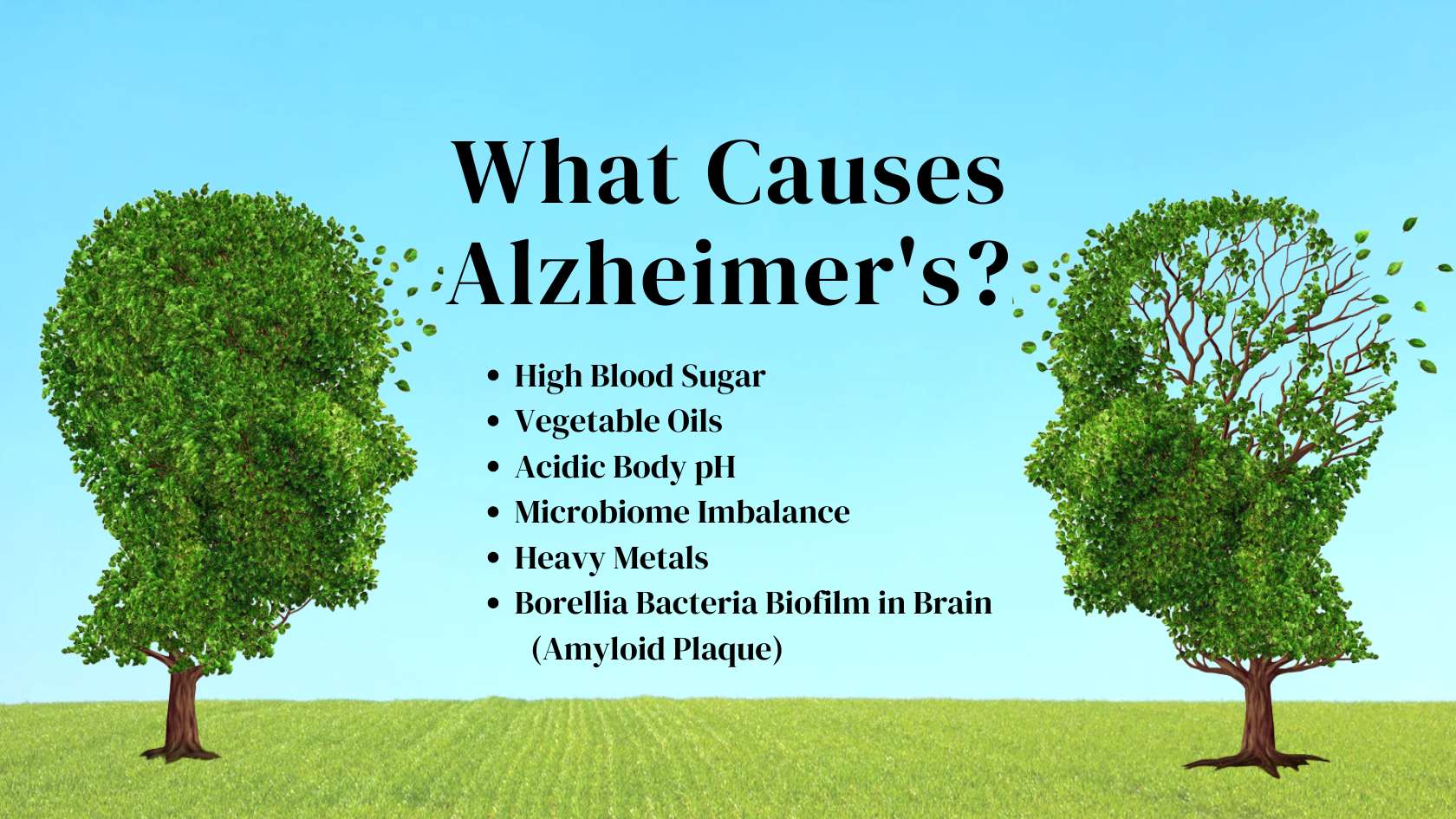
Alzheimer’s Disease is a major cause of death, affecting 50 million people in the world. This is projected to more than double by 2050 to 131.5 million people.
The Takeaway:
- Alzheimer’s (AD) no longer a mystery. My mother died of Alzheimer’s, as did her mother and her grandmother. Now we know Alzheimer’s primary causes. They are high blood sugar, vegetable oils, Acidic pH, microbiome imbalance, heavy metals, and Borellia Spirochete Bacteria Biofilm Amyloid Plaque in the brain.
- AD is a Metabolic Disease Related to High Blood Sugar and Acidic pH.
- How Does Borellia Spirochete Bacterial Biofilm Calcify into Amyloid Plaque? Doctors and Scientists have been blackballed and rejected for saying this for decades. Now the truth is coming out.
- Alzheimer’s Linked to Microbiome Imbalance.
- Alzheimer’s and Periodontal Disease.
- Heavy Metals especially Aluminum a Factor for AD Risk.
- Seven Steps to Eradicate Alzheimer’s: Increase Saturated Fats, Low Carb diet, Monitor Body pH, Eliminate Borellia Spirochetes, Detox Heavy Metals, Protect Microbiome, Reduce exposure to nasty substances.
1. Alzheimer’s no longer a mystery.
 Contrary to common belief, Alzheimer’s disease can be cured. It has many causes, primarily high blood glucose, high-carb diet, acidic pH, Spirochetes Borellia biofilm that hardens into amyloid plaque in the brain, heavy metal toxins, lack of aerobic movement, and sometimes periodontal disease. All the evidence points to lifestyle factors, especially diet, as the driving force of dementia. Alzheimer’s is linked to many other chronic metabolic diseases, like Diabetes, Hypertension, and CVD, suggesting that we can ELIMINATE ALL of these diseases in similar ways.
Contrary to common belief, Alzheimer’s disease can be cured. It has many causes, primarily high blood glucose, high-carb diet, acidic pH, Spirochetes Borellia biofilm that hardens into amyloid plaque in the brain, heavy metal toxins, lack of aerobic movement, and sometimes periodontal disease. All the evidence points to lifestyle factors, especially diet, as the driving force of dementia. Alzheimer’s is linked to many other chronic metabolic diseases, like Diabetes, Hypertension, and CVD, suggesting that we can ELIMINATE ALL of these diseases in similar ways.
Alzheimer’s Global Cost is now $1,313,400,000 per year. Yes, that’s $1.3 trillion.
In 2019, the annual global societal costs of dementia were estimated at US $1313.4 billion for 55.2 million people. But unlike other diseases, the greatest economic costs of dementia are not for doctors and medicines, but rather for nursing home and long-term home care, which costs over $50,000 per year, because there’s no cure or effective treatment for dementia. People living with Alzheimer’s require assistance for the rest of their lives.

2. AD is a Metabolic Disease Related to High Blood Sugar and Acidic pHScientists call AD “Type 3 Diabetes” because of its link to sugar consumption and extremes in blood glucose levels going up and down through the day. The root of the Alzheimer’s epidemic is in our most common foods: flour, bread, noodles, potatoes, pasta, cake, corn, refined grains, and root vegetables. These high-carb foods immediately convert to sugar and spike our blood glucose levels just as fast as table sugar. The underlying damage of Alzheimer’s begins many years earlier, with sugar, carbs, heavy metals, spirochete bacteria biofilm, and lack of movement.

3. How Does Borellia Spirochete Bacterial Biofilm Calcify into Amyloid Plaque?
Doctors and Scientists have been blackballed and rejected for saying this for decades. Now the truth is coming out.
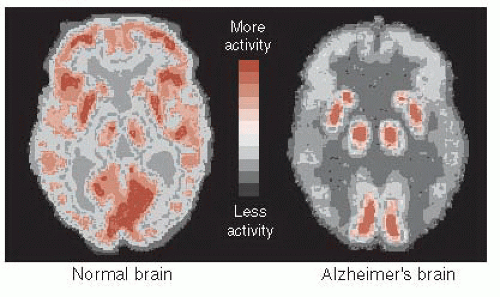 A clear causal relationship between Borellia Burgdorferi bacteria and Alzheimer’s disease, by Herbert B. Allen was published in the Journal of Alzheimer’s Disease. In his words:
A clear causal relationship between Borellia Burgdorferi bacteria and Alzheimer’s disease, by Herbert B. Allen was published in the Journal of Alzheimer’s Disease. In his words:
“Utilizing the pathology and microbiology found in tissue from patients with documented Alzheimer’s disease (AD), the pathogenesis of this fateful disorder has been made clear. Borrelia burgdorferi and Treponema denticola spirochetes enter the brain, mostly via neuronal pathways and the entorhinal circulation. These organisms easily pass through the blood-brain barrier and have an affinity for neural tissue. Once in the brain, the spirochetes make intra- and extracellular biofilms, and it is the biofilms that create the pathology. Specifically, it is the intracellular biofilms that are ultimately responsible for neurofibrillary tangles and dendritic disintegration. The extracellular biofilms are responsible for the inflammation that initially is generated by the first responder, Toll-like receptor 2.
Translation: A group of bacteria seeps into the brain. To protect the colony from invasion, the bacteria secrete a polysaccharide sugar slime layer we call “Biofilm” within the brain. Once covered and protected in a biofilm, the spirochete microbes become undetectable, resistant to the body’s immune system and to antibiotics. Over time, hard calcification of the Borellia biofilm destroys brain cells, and is called “Amyloid Plaque”. Alzheimer’s is similar to Lyme and Syphilis, which can cause dementia, and are also caused by Borellia bacteria.
A recent study of Alzheimer’s brains by Senejani showed “the presence of B. burgdorferi antigen and DNA in patients with AD pathology, and among those, one was previously diagnosed with Lyme disease. Interestingly, a significant number of Borrelia-positive aggregates with a known biofilm marker, alginate, were found along with the spirochetal structures. Our immunohistochemical data also showed that Borrelia-positive aggregates co-localized with amyloid and phospho-tau markers. To further prove the potential relationship of B. burgdorferi and amyloids, we infected two mammalian cell lines with B. burgdorferi which resulted in a significant increase in the expression of amyloid-β and p-Tau proteins in both cells lines post-infection”. Source:
Another study of Lyme disease patients confirmed that the SAME persistent infection with Spirochete biofilm may have long-term consequences on the Central Nervous System and dementia we call “Alzheimer’s”. Source
According to Dr. Alan B. McDonald:
Borrelia burgdorferi spirochete, same the causative agent of Lyme disease and Syphillis, is also found in Alzheimer’s disease brain tissues, not just in spirochete form, but a known antibiotics-resistant biofilm form, and its co-localized amyloid markers. In summary, this study provides evidence for a likely association between B. burgdorferi infections and biofilm formation, AD pathology, and chronic neurodegenerative diseases like Alzheimer’s.
In this video Dr. Alan B McDonald MD shows clear evidence that chronic Borrelia brain infection induced Alzheimer’s disease. Evidence from microbial cultures, in situ DNA hybridization using Borrelia specific DNA probes and PCR amplification of total Alzheimer DNA recovered Borrelia specific DNA sequences in all brains studied.
4. Alzheimer’s Linked toMicrobiome Imbalance, Pesticides, Farming Chemicals,
A recent study revealed that specific bacteria in the intestine are directly linked to cognitive decline in Alzheimer’s patients. This highlights the gut microbiome as a key area of research for Alzheimer’s and other forms of dementia, and that could lead to new ways to treat the disease.
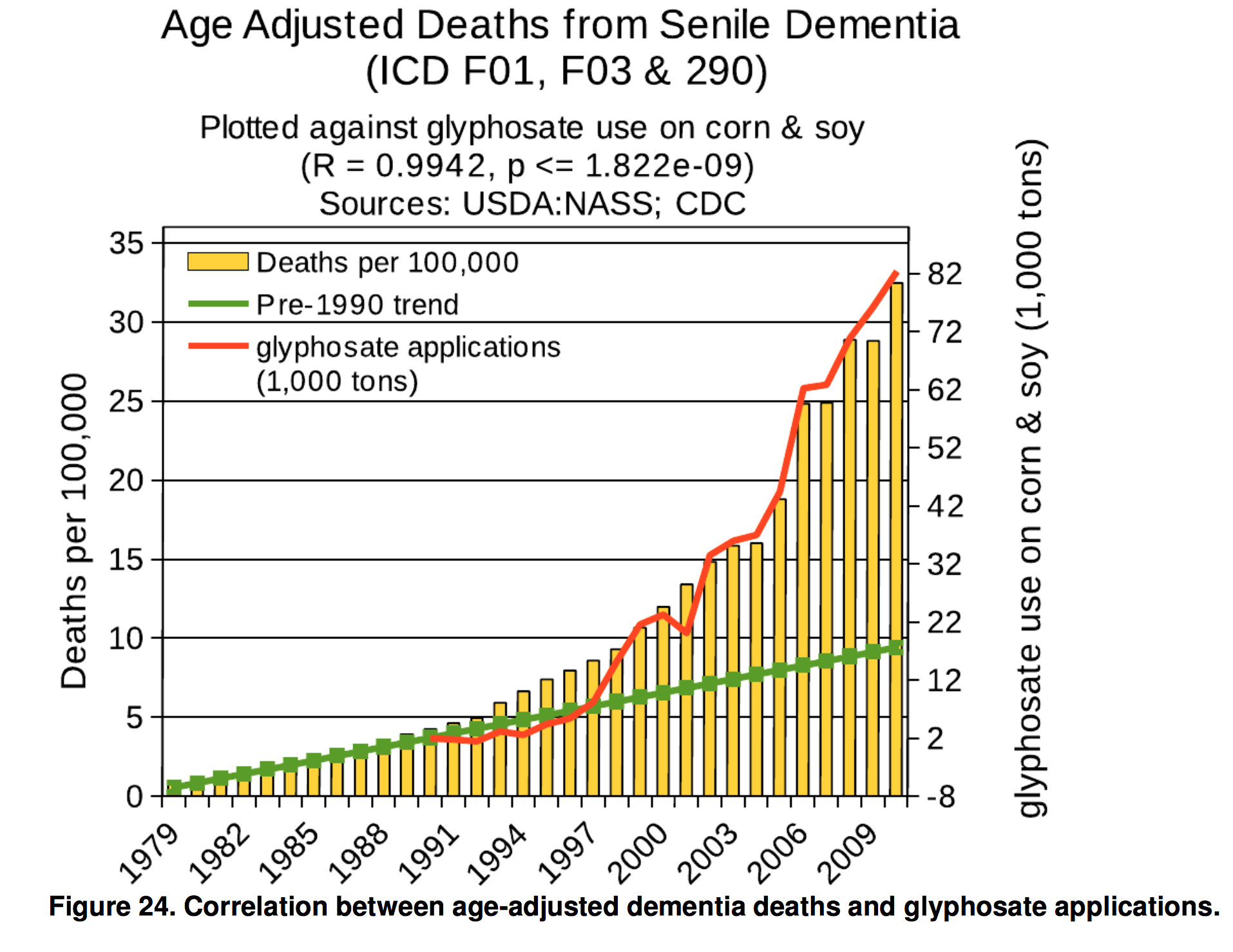
What Do Glyphosate and Agro-Chemicals have to do with increasing Alzheimer’s?
We know that farming chemicals disrupt the gut microbiome, by eradicating the beneficial bacteria in the intestines. Scientists at a Research Centre of Brescia, Italy set out to understand how the gut microbiota in Alzheimer’s patients affects brain health and behavior. They invited human participants, including 69 with Alzheimer’s disease and 64 healthy controls, who donated blood for research, along with gut microbiota via stool samples.
What happened? At least 10 days after the transplants, the rats were given challenging behavioral tests to evaluate memory performance and other traits associated with Alzheimer’s disease. The Rats with Alzheimer’s microbiome transplants showed impaired memory in the hippocampal area of the brain.
Another study concluded that a fundamental cause of AD is damage to the GMBA (gut microbiota brain axis). They observed a close relationship between gut microbiota composition, nutritional habits, brain inflammation caused by bacteria or bacterial brain migration. This leads to brain synapse failure, changes in mood, and poor memory.
5. Alzheimer’s and Periodontal Disease
There is strong evidence of a direct link of causation between the existence of periodontal gum disease and Alzheimer’s (AD). Some studies show spirochetes bacteria common in gum disease were observed in the brain in more than 90% of AD cases.
Tips to Clean up Your Mouth:
The tongue typically has a very heavy biofilm covering consisting of anaerobic bacteria, viruses, fungi, and even protozoa. Because of this, the tongue plays the #1 leading role as a source of pathogen that get into the body. The protocol for a healthy tongue should include the following, from Thomas E. Levy, MD, JD:
Use a tongue scraper to mechanically remove as much biofilm as possible. This takes seconds. Many YouTube videos demonstrate the simple technique. Do this a minimum of twice daily (first thing in the morning, last thing at night). Optimally, do it after every meal, which can reseed new microbes.
Scrape your tongue FIRST, before you brush your teeth. Routinely brush your tongue as well with toothbrush and toothpaste.
Swish and gargle with an antiseptic mouthwash after every scraping.
Consider regular oral irrigation daily before bed.
6. Heavy Metals esp. Aluminum a Factor for AD Risk.
Aluminum, Mercury, and Cadmium are highly toxic metals that are present in the tissues of all AD patients. Aluminum is a well-established neurotoxin linked to neurodegenerative diseases including Amyotrophic Lateral Sclerosis (ALS), Alzheimer’s Disease (AD), Dementia, Gulf War Syndrome, Multiple Sclerosis, and Parkinson’s.
Nano-Aluminum ((AI) in vaccines regularly causes direct neurological inflammation and lifelong chronic illness. Other sources of heavy metals are nano-particulates in the air we breathe, rainwater, vaccines, silver-colored dental fillings, cookware, baking pans, antiperspirants, sunscreen, toothpaste, aluminium foil, teapots, lipstick, cosmetics, preservatives, and large ocean fish such as Mackerel, Shark, Swordfish, Tuna, and Cod. These fish toxins are most concentrated in large fish at the top of the food chain.
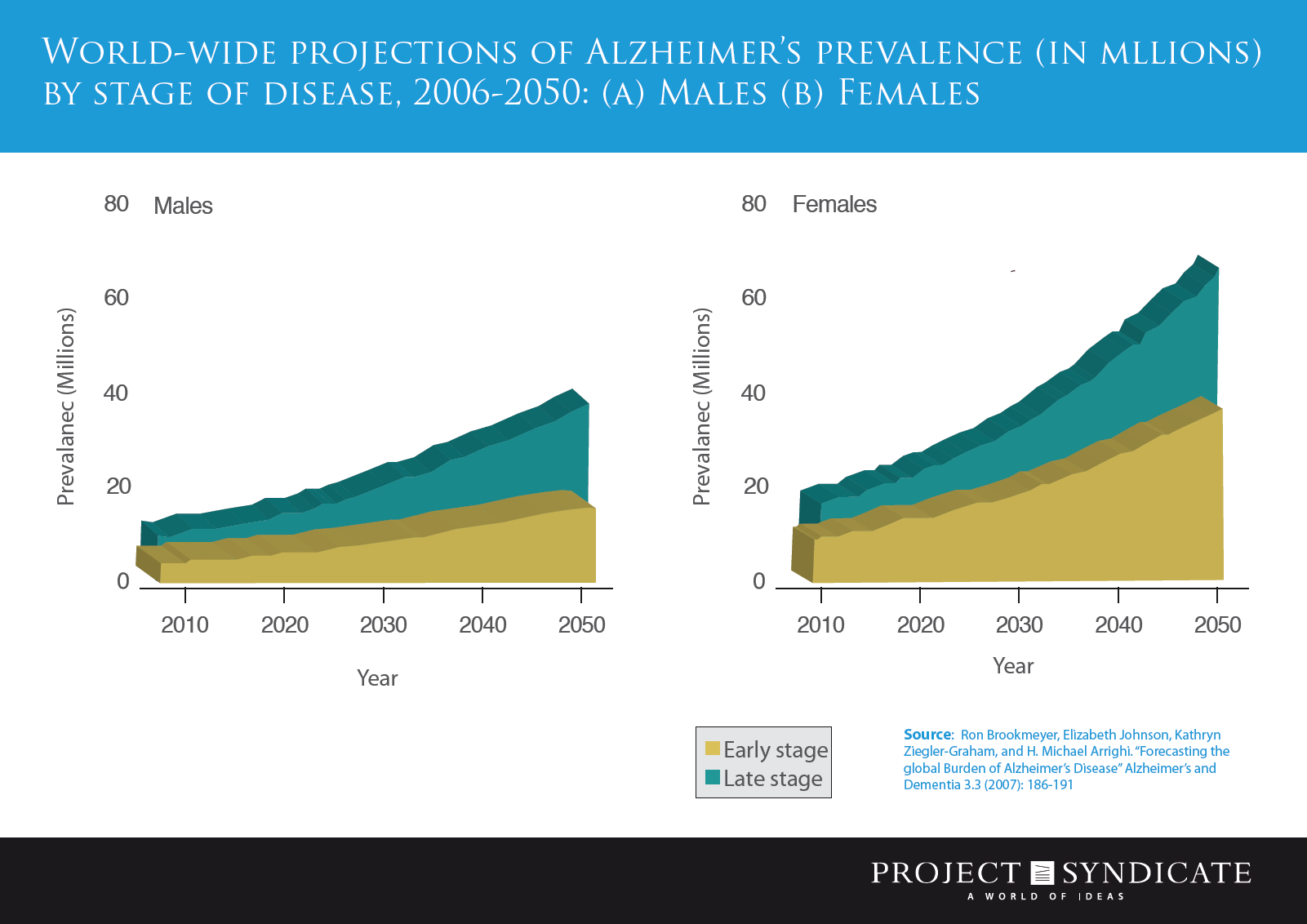
6. Seven Steps to Eradicate Alzheimer’s
1. Increase Animal Fats
Go back to the original human diet of saturated animal fats, such as butter, ghee. Coconut oil is also acceptable, as it is a saturated fat.
2. Balance Blood Glucose Levels with strict low-carb or Ketogenic diet.
Measure your Blood glucose after meals. Reduce consumption of sugar and carbs such as bread, potatoes, sweets, noodles, cake, white rice, sodas, and packaged cereals (Our favorite foods that immediately convert to glucose sugar rush). A Ketogenic diet (KD) is a nutritional program very high in fats and low in carbohydrates and proteins (90% fat, 4% carbohydrate, 6% protein) developed in the 1990s as a treatment for chronic disease. The sugar shortage leads the body to break down and oxidate fats and produce ketones, so body fats convert to an alternative energy-metabolism instead of glucose especially in the brain.
3, Monitor Body pH,
Measure you pH frequently, and consume Baking soda daily.
1/2 teaspoon of baking soda in 1/4 cup water once or twice a day will help alkalinize your body.
Eat an alkaline diet of plenty of fresh resist and veggies. See this article here.
4. Eliminate Spirochetes Bacteria in body, especially in the mouth before it spreads to the brain and becomes a fixed biofilm. Try to catch the bacteria before they get into the brain with anti-bacterials, in this order of preference:
- Cinnamon oil
- Pure Garlic or Garlic Oil
- Proteolytic Enzymes
- Clove oil
- Curcumin (Turmeric)
- Apple Cider Vinegar
- Oregano oil
- MMS Chlorine Dioxide
- After they enter the brain, the bacteria may still be eradicated using:
- EDTA
- Infra-red Sauna
- Hot Yoga, Bikram Yoga
- MMS Chlorine Dioxide
5. Detox Heavy Metals. Test your heavy metals levels, especially aluminum and mercury. Suggest Cilantro and Ionic Footbath for heavy metals by Dietrich Klinghardt, MD, PhD, Lyme Disease Treatment Protocol. Or his Lyme book: https://lymebook.com/dietrich-klinghardt-treatment-of-lyme-disease. Or a free pdf here: https://ozonewithoutborders.ngo/wp-content/uploads/2021/02/Lyme.pdf
6. Protect Microbiome. Take Probiotics, Avoid farming chemicals that disrupt the microbiome. Eat 100% organic. Avoid Pesticides. Eat high-fiber food, Alkaline diet, Exercise, Test Heavy Metals, Detox, Laugh, Sing and enjoy life! Does this sound familiar?
7. Reduce your exposure to these substances that Make AD Worse:
Certain foods, diseases, and activities tend to exacerbate Alzheimer’s. Dehydration, stroke, diabetes, nicotine, haloperidol drug, sugar consumption, and diet soft drinks have all been shown to cause worsening of Alzheimer’s disease (AD) due their impact on biofilms. If Penicillin were administered before the spirochetes form protective biofilms in the brain, this could very likely prevent Alzheimer’s, says Dr. Joseph R Nemeth, MD. https://www.youtube.com/watch?v=O_7Phu6vl4M
“Alzheimer’s is a preventable disease. Dietary carbohydrates lead to Alzheimer’s disease. Choose whether to favor fat or carbs.” Dr. David Perlmutter, author of “Grain Brain”
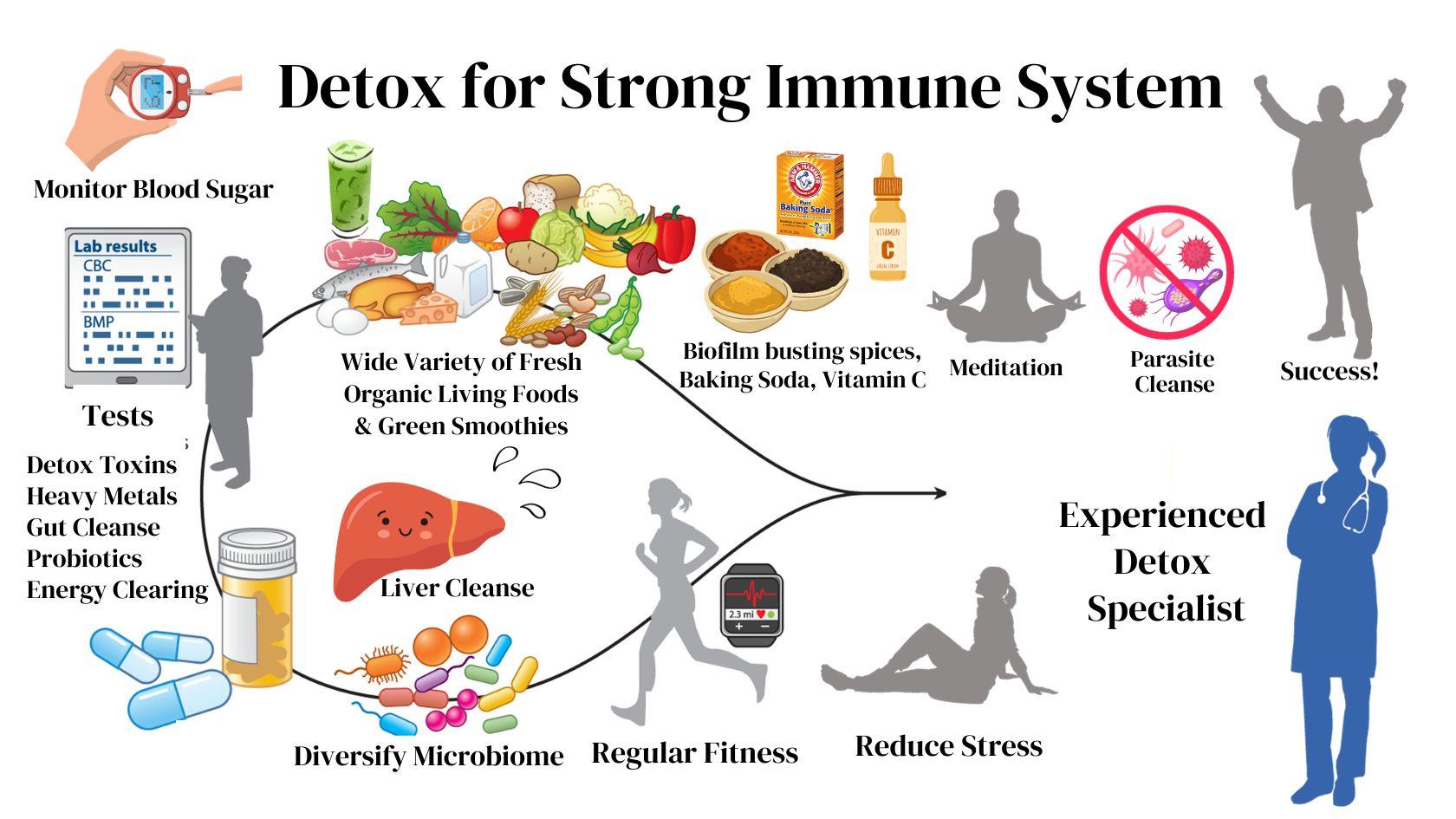
More Tips to Beat Alzheimer’s:
- Eat healthy oils like Coconuts and coconut oil (coconut oil actually shows promise as an effective Alzheimer’s treatment by itself)
- Avocado oil, raw nuts, and grass-fed meats or poultry. Avoid refined or blended oils.
- Enjoy Organic Butter made from raw, grass-fed dairy
- Enjoy Grass-fed meats or pasture raised poultry
- Avoid sugar, refined fructose.
- Avoid grains.
- Optimize your gut flora with fermented foods.
- Practice Intermittent fasting to stimulate Ketosis, so your cells will remember how to burn fat.
- Exercise regularly.
- Optimize your vitamin D levels with safe sun exposure.
- Skip or remove Silver-colored Dental mercury amalgam fillings, that are 50% mercury, a major source
- Avoid vaccines, anticholinergics, and statin drugs.
- Challenge your mind daily. Mental stimulation is associated with a decreased risk of AD.
 Srijana, aka Jane Barthelemy is a medical intuitive, author, and healer. She has her MBA in financial management and has practiced Tibetan Buddhist meditation for over five decades, residing in the Rudrananda Ashram in the USA for 35 years. She practices kinesiology, craniosacral therapy, Acunect, and BodyTalk – an infusion of Chinese – Ayurvedic wisdom. She teaches Qigong, Taichi, Daoist sexuality, and Kundalini activation. Her medical Qigong training is with Mantak Chia, Khamto Lee, Daniel Villasenor, Zhongxian Wu, Dr. Ka’imi Pilipovich, Franco Mescola, Richard Leirer, and Lam Kam Chueng. She has her BS in Italian Opera and MBA. Her two paradigm-changing cookbooks show how to build health with unprocessed foods. Her upcoming books include: “Heal Your Past Lives”, and “Buddha Speaks – Channeled Passages from the Master”. She is on the faculty of NewEarth University and LearnDesk. Her websites are FiveSeasonsMedicine.com and JanesHealthyKitchen.com. Jane lives in Bali with her Bhutanese husband, Lama D.
Srijana, aka Jane Barthelemy is a medical intuitive, author, and healer. She has her MBA in financial management and has practiced Tibetan Buddhist meditation for over five decades, residing in the Rudrananda Ashram in the USA for 35 years. She practices kinesiology, craniosacral therapy, Acunect, and BodyTalk – an infusion of Chinese – Ayurvedic wisdom. She teaches Qigong, Taichi, Daoist sexuality, and Kundalini activation. Her medical Qigong training is with Mantak Chia, Khamto Lee, Daniel Villasenor, Zhongxian Wu, Dr. Ka’imi Pilipovich, Franco Mescola, Richard Leirer, and Lam Kam Chueng. She has her BS in Italian Opera and MBA. Her two paradigm-changing cookbooks show how to build health with unprocessed foods. Her upcoming books include: “Heal Your Past Lives”, and “Buddha Speaks – Channeled Passages from the Master”. She is on the faculty of NewEarth University and LearnDesk. Her websites are FiveSeasonsMedicine.com and JanesHealthyKitchen.com. Jane lives in Bali with her Bhutanese husband, Lama D.
Resources:
- A Novel Approach to the Treatment and Prevention of Alzheimer’s Disease Based on the Pathology and Microbiology, https://content.iospress.com/articles/journal-of-alzheimers-disease/jad210429
- Borrelia Burgdorferi in the Alzheimer’s Brain, https://lymediseaseassociation.org/lyme-tbd/research-other-pub/borrelia-burgdorferi-in-the-alzheimers-brain/
- Brave Scientists Dr. Herbert Allen – Spirochetes and Alzheimer’s Disease, https://www.youtube.com/watch?v=Mr17woXH5Ec
- ALZHEIMER PLAQUES ARE BIOFILM COMMUNITIES OF BORRELIA, https://www.youtube.com/watch?v=pLcDp2kdQF0
- How Did We Get ADDICTED to “HEALTHY” foods we eat EVERY DAY?, https://janeshealthykitchen.com/addicted-healthy-foods/
- Borrelia burgdorferi Co-Localizing with Amyloid Markers in Alzheimer’s Disease Brain Tissues, https://www.ncbi.nlm.nih.gov/pmc/articles/PMC8842785/
- Detecting Borrelia Spirochetes: A Case Study With Validation Among Autopsy Specimens, https://pubmed.ncbi.nlm.nih.gov/34040573/
- 7 Natural Agents That Disrupt Biofilms, https://drjockers.com/7-natural-agents-disrupt-biofilms/
- List of Biofilm Chronic Diseases, https://www.ppt-health.com/biofilms-fibrin-and-cysts/list-of-biofilm-chronic-diseases/
- The Effects of Sugars on the Biofilm Formation of E. coli https://www.researchgate.net/publication/307141950_The_Effects_of_Sugars_on_the_Biofilm_Formation_of_E_coli_185p_on_Stainless_Steel_and_Polyethylene_Terephthalate_Surfaces_in_a_Laboratory_Model
- Cancer and Miracle Mineral Solution or MMS as Chlorine Dioxide, https://miraclemineralsolution-mms.com
- https://healthrevolutionsolution.com/pages/mms-beginners-guide
- *Natural & Advanced 3D Precise Therapy Successfully Treats Various Chronic Inflammatory Diseases, https://inflammationscure.com
- Does Gum Disease Cause Alzheimer’s Disease? (RESEARCH FINDS POTENTIAL LINK), https://www.youtube.com/watch?v=O_7Phu6vl4M
- https://www.mja.com.au/journal/2009/191/9/otitis-media-viruses-bacteria-biofilms-and-vaccines
- Dietrich Klinghardt, MD, PhD, Lyme Disease Treatment Protocol,
or https://lymebook.com/dietrich-klinghardt-treatment-of-lyme-disease
https://ozonewithoutborders.ngo/wp-content/uploads/2021/02/Lyme.pdf - Oral Biofilms from Symbiotic to Pathogenic Interactions and Associated Disease –Connection of Periodontitis and Rheumatic Arthritis by Peptidylarginine Deiminase https://www.frontiersin.org/articles/10.3389/fmicb.2018.00053/full
- Book Excerpt: New Paradigms in Lyme Disease Treatment, Dietrich Klinghardt, MD, PhD, https://www.townsendletter.com/e-letter-14-book-environment_and_toxins_in_lyme_treatment/
- Anti-spirochete herbs to treat Lyme disease, https://theholisticgardener.com/2018/07/03/anti-spirochete-herbs-to-treat-lyme-disease/
- Enzymatic dispersion of biofilms: An emerging biocatalytic avenue to combat biofilm-mediated microbial infections, https://www.jbc.org/article/S0021-9258(22)00795-5/fulltext
- The systemic oral health connection: Biofilms, https://pubmed.ncbi.nlm.nih.gov/36401454/
- OBM Geriatrics Alzheimer’s Disease Parsing the Pathways Leading to the Disease Based on the Spirochete/Biofilm Hypothesis, https://www.researchgate.net/publication/339434219_OBM_Geriatrics_Alzheimer’s_Disease_Parsing_the_Pathways_Leading_to_the_Disease_Based_on_the_SpirocheteBiofilm_Hypothesis
- 54 Natural Ways to Inhibit Biofilms, https://health.selfdecode.com/blog/44-science-backed-ways-to-inhibit-biofilms-naturally-with-references/
- https://neupsykey.com/alzheimers-disease-2/
- Multifaceted effects of aluminium in neurodegenerative diseases: A review, https://pubmed.ncbi.nlm.nih.gov/27479193/
- The Link Between Periodontitis and Alzheimer’s Disease: Reality or Yet Another Association, https://link.springer.com/article/10.1007/s40496-022-00319-8
- Alzheimer’s disease – a neurospirochetosis. Analysis of the evidence following Koch’s and Hill’s criteria, https://www.ncbi.nlm.nih.gov/pmc/articles/PMC3171359/
- Alzheimer’s Disease—Yes, It’s Preventable! by Dr. Mercola
- Reboot Your Gut. Optimizing Health and Preventing Infections Disease, Opinion by Thomas E. Levy, MD, JD, http://www.orthomolecular.org/resources/omns/v15n16.shtml
- https://alz-journals.onlinelibrary.wiley.com/doi/full/10.1002/alz.12901
- https://www.sciencealert.com/in-a-huge-first-scientists-transfer-alzheimers-to-healthy-young-animals
- The Potential Role of Gut Microbiota in Alzheimer’s Disease: From Diagnosis to Treatment, https://www.ncbi.nlm.nih.gov/pmc/articles/PMC8840394/Intention


